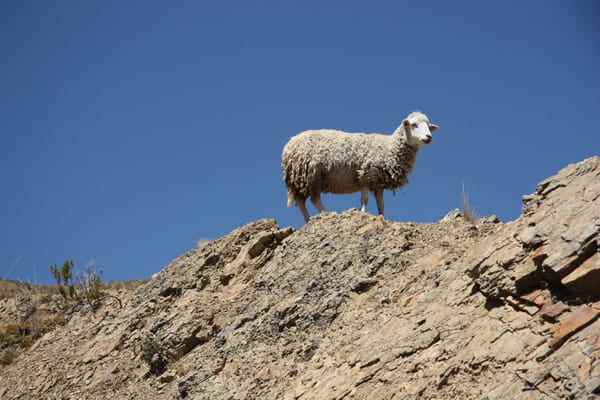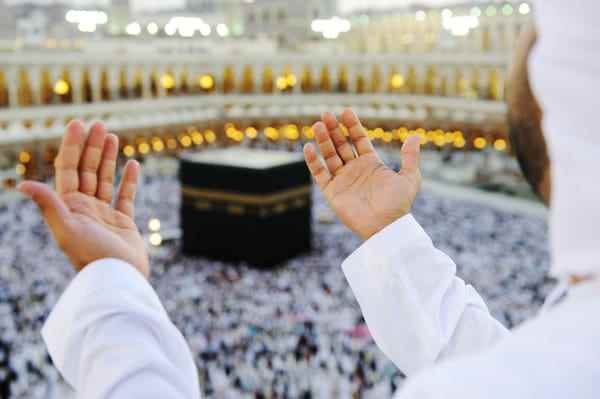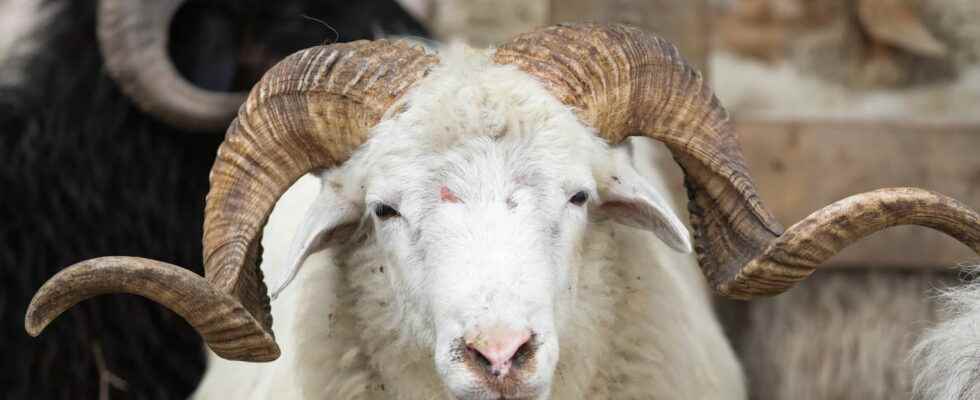AID EL KEBIR 2022. The feast of Aïd el-Kébir, also called Aïd el-Adha, takes place on Saturday July 9, 2022. This great festival of Muslims includes, among other things, the slaughter of a sheep. How does it work?
[Mis à jour le 9 juillet 2022 à 16h01] Eid el-Kébir takes place on Saturday July 9, 2022. This holiday, also called Eid al-adha, can be translated as “festival of sacrifice”. Muslim practitioners celebrate, on this occasion, the end of the pilgrimage to Mecca. This must be held on the tenth day of the Muslim lunar calendar, which is why its date differs from one year to another. During this festival, a sheep is traditionally sacrificed. This refers to an episode of the Koran in which Ibrahim (Abraham) was going to sacrifice his son in order to testify to his faith in God. Before he runs the child is replaced by a sheep by the Archangel Gabriel.
According to the Ministry of Agriculture, more than 100,000 sheep will be sacrificed in France during the three days of the Eid el-Kébir festival. The latter has thus produced a practical guide so that the festival can be organized jointly between professionals, Muslim associations and animal protection associations. These are critical of Eid el-Kébir. In a July 6 tweet, the Brigitte Bardot Foundation underlines “the atrocity experienced by thousands of animals destined for the long and cruel agony of slaughter without stunning”. It is indeed this aspect of the ritual that is severely frowned upon.
Sheep, lamb, cow, goat… The sacrifice of Eid el-Kébir is a key moment for practicing Muslims, but also the source of intense controversy every year. According to the Ministry of Agriculture which published on its website in May 2022 a press release and a “practical guide” relating to the organization of Eid el-Kébir, with the Ministry of the Interior, it is indeed “more than 100,000 sheep” which are slaughtered each year. A “real logistical challenge” that needs to be regulated and organised. If the slaughter must be carried out in certified slaughterhouses, the organization of Eid el-Kébir may require in some departments the establishment of temporary slaughterhouses, approved and which only operate during the three feast days.
The list of approved slaughterhouses during Eid el-Kébir is published each year. In the excerpt from the Jo of July 2, 2022, there were about thirty of these slaughterhouses throughout the country. Slaughtering outside an approved structure is prohibited in France and punishable by a fine of 15,000 euros and six months’ imprisonment. As for the transport of live animals in conditions contrary to their well-being, this is also an offence, punishable by a fine of 750 euros.
ZOOM – The slaughter of an animal, an obligation for Muslims?
Eid el-Kébir is considered by Muslims as a celebration of their faith. Many traditions accompany this period. Muslims share prayers and meals. The most famous tradition of Eid el-Kébir is the sacrifice of an animal. It is usually a sheep, a goat or a calf. Animals must be at least one to two years old. Tradition commands the head of the family to kill the animal by draining it of its blood, without knocking it out and using a very sharp knife: the suffering of the animal must be minimized.

Many families make the choice to sacrifice a sheep in a specialized slaughterhouse or to order the meat of an animal killed according to the rite. It is customary to divide the meat into three equal parts. The first belongs to the family, the second to neighbours, friends, colleagues and acquaintances, the third to the poor and destitute. The poorest are not required to practice this sacrifice. For some Muslim leaders, the sacrifice of the animal is a recommendation – which has become by force of family and cultural habits, a rite which seems obligatory, but which can very well be replaced by a gift made to the needy, if this corresponds to its financial equivalent.
In France, Eid el-Kébir 2022 / 1443 (year of the Muslim calendar) begins on Saturday July 9. This date is fixed by the Great Mosque of Paris which uses an astronomical calculation. A method that tends to impose itself in the authorities of Islam in France, but which does not satisfy all practicing Muslims in France. Some criticize him indeed for setting back the traditional observation of the crescent moon during the night of doubt / announcement. The Eid el-Kébir festival lasts four days and the sacrifice must take place before sunset on the thirteenth day of the month according to tradition.
PRESS RELEASE – The Great Mosque of Paris announces that the date of the#AidalAdha will be on Saturday, July 9, 2022. It will organize two prayers: at 7:30 a.m. and at 8:15 a.m. pic.twitter.com/874EFoIC3Z
— Great Mosque of Paris (@mosqueedeparis) June 29, 2022
Practicing Muslim believers celebrate Eid el-Kébir the 10th day of the lunar month of Dhûl hijja (the last month of the Hijri calendar, based on the moon), which is also the “month of the great pilgrimage” of the hajj. As a result, the date of Eid el-Kébir, like that of the beginning or the end of Ramadan, “retreats” about eleven days each year in the civil calendar. The date of Eid el-Kébir may vary from one country to another, such as during the Ramadan, but also from one practitioner to another. In France, it is the French Council for Muslim Worship (CFCM), the main representative body of Islam in France, which confirms the official date of Eid in due time.
This celebration is also called Eid al-Adha (the “Feast of Sacrifice”). The celebration of Eid el-Kébir combines a great prayer for believers and traditional sheep sacrifices that take place around the world, giving rise to a meal of sharing with loved ones and people in need. The tradition of the “Feast of Sacrifice” also wants the prayer at the beginning of Eid to precede the sacrifice of the animal. After the prayer, the celebration takes place over four days. The first day, however, remains the most important for Muslims. It marks the end of the pilgrimage to Mecca and, after the great collective prayer which takes place in the morning, the faithful meet for the sacrifice before sharing a meal together. The faithful put on their best clothes for this feast and multiply gifts and alms.
In the Muslim tradition, Eid el-Kébir commemorates Ibrahim’s submission to his God (Abraham in the Bible), who should serve as a model for all believers. Along with Eid al-Fitr (the feast of breaking the fast), it is one of the two major Muslim holidays. It requires sacrificing a herd animal, usually a sheep, then sharing the meat with loved ones but also disadvantaged people, in memory of Abraham’s submission to God, the latter having shown himself ready to offer the life of his son, who was substituted in extremis by a sheep.
According to the Quran, this prophet received in his dreams the divine order to sacrifice his son, Ishmael. The latter, brought up in the faith, agrees to be immolated by his father. The Devil intervenes and tries to convince the protagonists not to practice the sacrifice, but Ibrahim throws seven pebbles at Satan. The father grabs a knife and puts it on Ishmael’s throat. But he fails to push it down. When he finally manages to cut the neck, he finds that the angel Jibril (Gabriel) has placed a sheep in the place of his son and that the latter is standing, unscathed, beside him.
For Muslims, Ibrahim’s faith, tested by God, was rewarded by the survival of his son. Eid el-Kébir remains a celebration of faith and mercy. This episode from the Koran corresponds to a story from the Bible: that of Abraham’s sacrifice of his son. This is interrupted by the arrival of an angel who announces to him that God is satisfied with his faith. A ram is sacrificed in place of the young man.
Eid, bereaved in 2015 by a stampede that killed more than 2,000 people in Mecca, is one of the most important celebrations of the Muslim religion, with the Ramadan. In Islam, Eid closes for millions of believers the Hajj, the period of pilgrimages which began two days earlier. Every year, Muslims visit the holy sites of their religion in Mecca, Saudi Arabia. Marking the end date of Hajj, the pilgrimage to Mecca is one of the five pillars of Islam. Eid el-Kébir celebrates the completion of these pilgrimages and represents a high point in spiritual and social life.
Practicing Muslims are called to pray in the morning during the solemn prayer organized in the mosques for the occasion. Each faithful is then invited to go to the approved slaughterhouses to carry out the animal sacrifice according to the ritual. And concerning the organization of this special day, the rituals differ according to the country. In Jordan, for example, Eid el-Kebir is celebrated with the preparation of special pastries, while in Kuwait, the celebration is spread over a week during which sweets are banned. In Pakistan, the Eid al-Adha festivities last for an entire month, during which believers fast for the first 10 days.
The “Feast of the Sacrifice”, as it is called, is synonymous with share. In many Muslim countries, the sacrificed animal is divided into “three thirds”: one third is consumed by its owner, another third is offered as a gift to family or friends, and the last third is distributed to the poor as alms. On this day of celebration, it would be strongly recommended to multiply gifts and alms.
The celebrations of Eid el-Kebir andEid al-Fitr have the same prayer in common, and only the moment when they take place differentiates them. Indeed, the Eid al-Adha prayer is celebrated earlier than that of Eid al-Fitr. In addition, the greeting formula “Aïd Mubarak” remains the same for these two festivals of the Muslim calendar.
How to wish Muslim relatives a happy Eid el-Kébir in France or in the Maghreb countries? On the “Feast of Sacrifice” (such as on the feast of Eid al-Fitr, or the feast of the end of the Ramadan fast), the traditional Muslim greeting “Eid mubarak” is used. It corresponds to the version in Arabic / Persian / Urdu, when “Aïd mabrouk” refers to the version of dialectal Arabic (darija). In French, this expression translates to “Bonne fête (de l’Aïd)”, “congratulations” or “joyeuse fête”, although the formula is redundant, since Eid is already a party.
Muslims greet each other with the words ‘Eid mubarak’ after performing the Eid prayer. Pronouncing these words is therefore not an obligation of the Muslim religion, although they are part of a strong cultural and religious tradition. “Eid” refers to the religious event, when “mubarak” wishes “may it be good for you” or “may God bless you”.
The best known name is Aïd el-Kébir (“the big party” in Arabic). L’expression is mainly used in the Maghreb. However, many countries, especially in the Middle East, more readily use the name Eid al-Adha (“Festival of Sacrifice”). In West and Central Africa, the term Tabaski is used. Eid el-Kebir should be distinguished fromEid al-Fitr (“little party”), which marks the breaking of the Ramadan fast with a shared meal.
Eid el-Kébir marks the end of another essential tradition for believers: that of pilgrimage to the holy places of Mecca, or Hajj. This ritual takes place between the 8th and 13th of the month of dhou al-hijja of the Islamic calendar. The Hajj is one of the five pillars of Islam, along with the profession of faith, daily prayers, almsgiving and Ramadan.

Certain rituals performed during pilgrimages to Mecca recall the episode of Ibrahim’s sacrifice. Thus, it is customary to go to Mina – a place located near the sacred city and supposed place where this prophet took his son – in order to throw stones on pillars. This act symbolizes faith and rejection of the temptation of the devil, like Ibrahim in the Koran.
